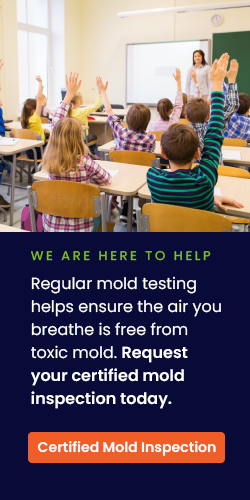As schools gradually reopen following the disruptions caused by the pandemic, it’s time to put the spotlight on the importance of mold inspections and air quality testing. Schools that have been unoccupied for months have a high chance of having water damage and moisture and mold issues. The CDC has warned people who are reopening buildings to keep an eye out for potential hazards like mold.
Why Mold Inspections Are Vital For School Districts
Mold causes more than a nasty smell; it leads to a stuffy nose, sore throat, and coughing. With about 6.1 million children under 18 suffering from asthma and other respiratory illnesses across the country, school authorities, as well as parents, need to be more serious about having the facility tested for mold regularly.
Parents especially have to think about childhood asthma: several studies have established a link between the condition and mold exposure. If you have reopened the school to find that mold has invaded the schoolrooms, it should be removed. It doesn’t matter what type of mold it is, its health effects can be different for different people.
Hire Professionals To Perform Reliable Mold Inspections
The Health and safety of the students and the staff should be a priority. Have certified professionals come out to your school and assess it thoroughly for mold growth. Even if you end up taking the remediation measures yourself, having experts perform the testing is vital in the post-pandemic era.
The water or moisture needed for mold growth can enter classrooms through leaky foundations, windows, pipes, roofs, and other structural openings. Water may also enter the school building due to misdirected sprinklers, poor drainage, or floods. The ventilation systems that pass through classrooms, building corridors, offices, and hallways can harbor dust mites, mold spores, and other airborne pollutants.
Regular mold inspections help catch and address the moisture issues in schools. These can be caused by high humidity during the summer or increased moisture due to carpet cleaning or painting.
Potential Health Risks Resulting from Mold Exposure In Schools
Mold in classrooms and school buildings affects students and staff alike, especially those with respiratory problems or allergies. It can lead to a wide range of health complications, including:
- Fatigue
- Headaches
- Flu symptoms
- Worsening or new asthma
- Irritated eyes
- Coughing
- Runny nose
- Nasal congestion
As a parent, you should find out how often the school cleans its building vents. That is especially important if your child has asthma or allergies. You should also ask about how often the school’s HVAC systems are cleaned.
Schools need to monitor indoor air quality to be able to identify and remediate these issues before they turn into bigger problems. The best way to do this is to schedule regular mold inspections and install air purification products like dehumidifiers, air exchangers, and ventilation systems.
Put Student And Staff Safety First: Schedule A Mold Inspection Today
If you would like to explore indoor air quality monitoring within your school district, or schedule a mold inspection before the school year starts, talk to us at IndoorDoctor. In fact, our certified IAQ technicians combine mold testing with meticulous on-site moisture inspections. Plus, they help you create an action plan to solve the problem. We offer virtual air quality testing as well. So, give us a call at 800-466-1522 or leave a message here to schedule an inspection today.







